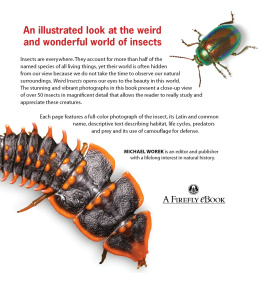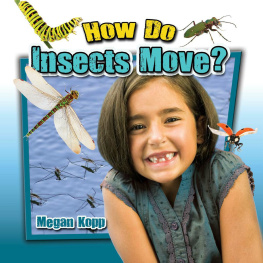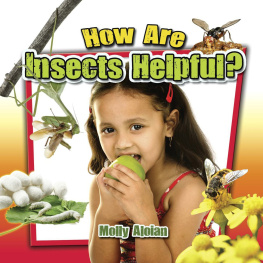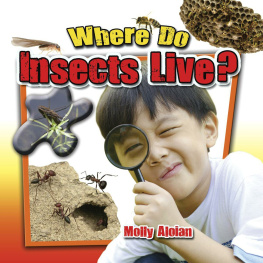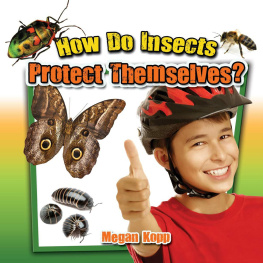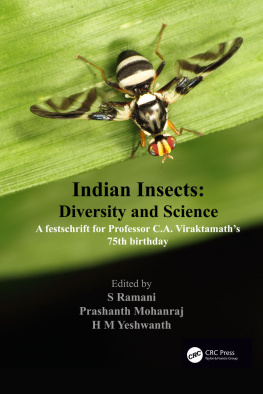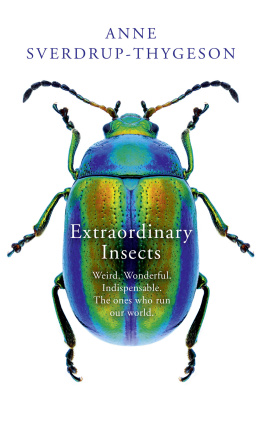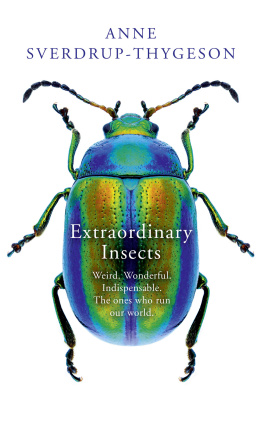Lanternfly
Pyrops sp.
Some of the larger planthoppers like this peanut-headed insect are misnamed lanternflies because they were once thought to produce light. There are many kinds of bioluminescent insects, but planthoppers are not among them. The long, peanut shaped protrusion from the head is mostly hollow and can sometimes be nearly as long as the insects body. Many have flashier hind wings that they spread when frightened, often revealing polka-dots or eye spots to startle would-be predators. All planthoppers suck sap out of plants and are harmless to people.




Published by Firefly Books Ltd. 2014
Copyright 2014 Moseley Road Inc.
All rights reserved. No part of this publication may be reproduced, stored in a retrieval system, or transmitted in any form or by any means, electronic, mechanical, photocopying, recording or otherwise, without the prior written permission of the Publisher.
Publisher Cataloging-in-Publication Data (U.S.)
Worek, Michael.
Weird insects / Michael Worek.
[64] p. : col. photos. ; cm.
Includes index.
Summary: A beautifully illustrated guide to some of the most weird and wonderful insects of the world.
ISBN-13: 978-1-77085-235-8
ISBN-13: 978-1-77085-234-1 (pbk.)
1. Insects -- Juvenile literature. I. Title.
595.7 dc23 QL467.2.M377 2013
Library and Archives Canada Cataloguing in Publication
Worek, Michael
Weird insects / Michael Worek.
Includes index.
ISBN 978-1-77085-235-8 (bound).
ISBN 978-1-77085-234-1 (pbk.)
1. Insects--Juvenile literature. I. Title.
QL467.2.M388 2013 j595.7 C2013-901247-8
Published in the United States by
Firefly Books (U.S.) Inc.
P.O. Box 1338, Ellicott Station
Buffalo, New York 14205
Published in Canada by
Firefly Books Ltd.
50 Staples Avenue, Unit 1
Richmond Hill, Ontario L4B 0A7
All images are copyright Nature Picture Library, jointly with the following photographers:
page 4, cover Chris Mattison; page 5 Kim Taylor; page 6 Alex Hyde; page 7 Kim Taylor; page 8 MYN / Niall Benvie; page 9 Chris Mattison; page 10 MYN / Seth Patterson; page 11 MYN / Niall Benvie; page 12 Alex Hyde; page 13 Chris Mattison; page 14, back cover top right ARCO; page 15 John Abbott; page 16 Kim Taylor; page 17 Kim Taylor; page 18 MYN / Clay Bolt; page 19 Chris Mattison; page 20 John Abbott; page 21 Nature Production; page 22 Alex Hyde; page 23 MYN / Clay Bolt; page 24 MYN / Marko Masterl; page 25 Chris Mattison; page 26 Kim Taylor; page 27 MYN / Niall Benvie; page 28 Nick Garbutt; page 29 ARCO; page 30 Kim Taylor; page 31 Mark Bowler; page 32 MYN / Mac Stone; page 33 Kim Taylor; page 34 MYN / Seth Patterson; page 35 Chris Mattison; page 36 MYN / John Tiddy; page 37 John Abbott; page 38 Alex Hyde; page 39 Chris Mattison; page 40 MYN / Joris van Alphen; page 41 Chris Mattison; page 42 Alex Hyde; page 43 MYN / Piotr Naskrecki; page 4445 Alex Hyde; page 46 Alex Hyde; page 47 MYN / Piotr Naskrecki; page 48 Alex Hyde; page 49 Alex Hyde; page 5051 Kim Taylor; page 52 Alex Hyde; page 53 Alex Hyde; page 54 MYN / Paul Harcourt Davies; page 55 Wild Wonders of Europe / Benvie; page 56 Alex Hyde; page 57 MYN / Brady Beck; page 58 Alex Hyde; page 59, back cover bottom left Chris Mattison; page 60 John Abbott; page 61 Kim Taylor; page 62 Kim Taylor; page 63 Kim Taylor.
The publisher gratefully acknowledges the financial support for our publishing program by the Government of Canada through the Canada Book Fund as administered by the Department of Canadian Heritage.
INTRODUCTION

There are more insects than any other kind of living thing in the world. There are so many that if you could count all the species of living things in the world, well over one million of them would be insects. In addition to being numerous, insects are endlessly fascinating and varied and, to us, sometimes, weird. Most of the really colorful and weird looking insects live in the warmest lands that lie around the equator, but interesting insects can be found just about anywhere in the world.
An insect is often defined as an organism with three pairs of legs and three body regions: the first is the head, the second is the thorax and the third is the abdomen. Insects also have a pair of antennae and external mouthparts.
The head contains the antennae, mouth and eyes. Some insects drink nectar, and have mouthparts modified into a tube, called a proboscis, to suck up liquid. Other insects have mouthparts that allow them to chew. The pair of antennae is used to perceive sounds, smells and vibrations. Insects can have compound eyes that are usually large with many lenses that let it see all around or they can have a simple eye that contains just a single lens. Most insects have both kinds of eyes.
The middle of the insects body, called the thorax, includes the legs and the wings. All insect legs have five parts and are adapted to let it move efficiently in its habitat. Wings are found in many different shapes and sizes, and are adapted to the insects special needs. The last section of the insects body, called the abdomen, contains the stomach, intestines, sexual organs and glands that secrete a scent for marking the insects territory or attracting a mate.
The insects in the book represent just a tiny fraction of the range and diversity of what we already know exists. But even this tiny sample is enough to suggest the riches that await anyone who takes the time to observe the insects around them.
Macleays Spectre
Extatosoma tiaratum
This huge stick insect is originally from Australia but it is now kept as a pet all over the world. Females, like the one shown here, are covered with small spike-like thorns for defense and can grow to 20 centimeters (8 inches) long. Only the males can fly and they blend in with the foliage for protection. Eggs can take up to four months to hatch; the female flicks them to the ground with her tail after she lays them.

Hazelnut Weevil
Curculio nucum
This little weevil is called a hazelnut weevil because it lays its eggs inside a hazelnut. Its long snout ends in a pair of strong jaws that allow the female weevil to drill a hole in the hard outer shell of the nut. Once the hole is drilled, the female puts an egg in the hole. When the egg hatches, the larva eats the inside of the nut.

